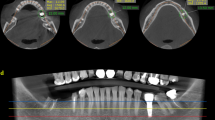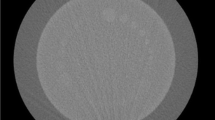Abstract
Objectives
The single-energy metal artifact reduction (SEMAR) algorithm effectively reduces metal artifacts in computed tomography (CT). The study aimed to evaluate the effect of the occlusal plane angle on metal artifacts caused by dental implants and zirconia upper structures, and the effectiveness of SEMAR for CT prognostic evaluation.
Methods
Part of a bovine rib was used as the mandibular implant phantom. First, the phantom immersed in a water tank was scanned using CT to obtain the control image under certain conditions. Subsequently, three titanium implant bodies were implanted in a straight line into the phantom, and a zirconia superstructure was attached. CT scans were performed. The CT-reconstructed images were obtained with and without SEMAR processing. Twelve regions of interest (ROIs) were set at the same site on each sagittal image, and the CT values were measured at all the ROIs. The CT values of the ROIs in the control images and those of the ROIs with and without SEMAR were compared.
Results
The variations in the occlusal plane angle during CT imaging negligibly affected the number of regions in which metal artifacts appeared. SEMAR improved the CT value of the trabecular bone, which was affected by metal artifacts.
Conclusion
This study showed that the occlusal plane angle occasionally did not affect the area of metal artifacts caused by dental implants or zirconia upper structures. Other results indicate that SEMAR is effective for accurately evaluating the alveolar bone around the implant body by reducing metal artifacts.





Similar content being viewed by others
References
Chen YC, Chen MY, Chen TY. Improving dental implant outcomes: CNN-Based system accurately measures degree of peri-implantitis damage on periapical film. Bioengineering (Basel). 2023;10:640.
Sohmura T, Hojoh H, Kusumoto N. A novel method of removing artifacts because of metallic dental restorations in 3-D CT images of jaw bone. Clin Oral Implants Res. 2005;16:728–35.
Almohandes A, Lund H, Carcuac O. Accuracy of bone-level assessments following reconstructive surgical treatment of experimental peri-implantitis. Clin Oral Implants Res. 2022;33:433–40.
Klinke T, Daboul A, Maron J. Artifacts in magnetic resonance imaging and computed tomography caused by dental materials. PLoS ONE. 2012;7: e31766.
Wagenaar D, van der Graaf ER, van der Schaaf A. Quantitative comparison of commercial and non-commercial metal artifact reduction techniques in computed tomography. PLoS ONE. 2015;10: e0127932.
Dong J, Hayakawa Y, Kannenberg S. Metal-induced streak artifact reduction using iterative reconstruction algorithms in X-ray computed tomography image of the dentoalveolar region. Oral Surg Oral Med Oral Pathol Oral Radiol. 2013;115:e63-73.
Gondim Teixeira PA, Meyer JB, Baumann C. Total hip prosthesis CT with single-energy projection-based metallic artifact reduction: impact on the visualization of specific periprosthetic soft tissue structures. Skeletal Radiol. 2014;43:1237–46.
De Crop A, Casselman J, Van Hoof T. Analysis of metal artifact reduction tools for dental hardware in CT scans of the oral cavity: kVp, iterative reconstruction, dual-energy CT, metal artifact reduction software: does it make a difference? Neuroradiology. 2015;57:841–9.
Huflage H, Grunz JP, Hackenbroch C. Metal artefact reduction in low-dose computed tomography: benefits of tin prefiltration versus postprocessing of dual-energy datasets over conventional CT imaging. Radiography (Lond). 2022;28:690–6.
Branco D, Kry S, Taylor P, Rong J. Evaluation of image quality of a novel computed tomography metal artifact management technique on an anthropomorphic head and neck phantom. Phys Imaging Radiat Oncol. 2021;17:111–6.
Chou R, Chi HY, Lin YH. Comparison of quantitative measurements of four manufacturer’s metal artifact reduction techniques for CT imaging with a self-made acrylic phantom. Technol Health Care. 2020;28:273–87.
Demirturk Kocasarac H, Ustaoglu G, Bayrak S. Evaluation of artifacts generated by titanium, zirconium, and titanium-zirconium alloy dental implants on MRI, CT, and CBCT images: a phantom study. Oral Surg Oral Med Oral Pathol Oral Radiol. 2019;127:535–44.
Smeets R, Schöllchen M, Gauer T. Artefacts in multimodal imaging of titanium, zirconium and binary titanium-zirconium alloy dental implants: an in vitro study. Dentomaxillofac Radiol. 2017;46:20160267.
Lell MM, Meyer E, Kuefner MA. Normalized metal artifact reduction in head and neck computed tomography. Invest Radiol. 2012;47:415–21.
Hakim A, Slotboom J, Lieger O. Clinical evaluation of the iterative metal artefact reduction algorithm for postoperative CT examination after maxillofacial surgery. Dentomaxillofac Radiol. 2017;46:20160355.
Khaleghi G, Hosntalab M, Sadeghi M. Neural network performance evaluation of simulated and genuine head-and-neck computed tomography images to reduce metal artifacts. J Med Signals Sens. 2022;12:269–77.
Zhou P, Zhang C, Gao Z. Evaluation of the quality of CT images acquired with smart metal artifact reduction software. Open Life Sci. 2018;13:155–62.
Hilgenfeld T, Juerchott A, Deisenhofer UK. Accuracy of cone-beam computed tomography, dental magnetic resonance imaging, and intraoral radiography for detecting peri-implant bone defects at single zirconia implants-An in vitro study. Clin Oral Implants Res. 2018;29:922–30.
Fontenele RC, Nascimento EH, Vasconcelos TV. Magnitude of cone beam CT image artifacts related to zirconium and titanium implants: impact on image quality. Dentomaxillofac Radiol. 2018;47:20180021.
Vasconcelos TV, Bechara BB, McMahan CA. Evaluation of artifacts generated by zirconium implants in cone-beam computed tomography images. Noujeim Oral Surg Oral Med Oral Pathol Oral Radiol. 2017;123:265–72.
Schulze R. CBCT artefact-burden of zirconia-based as compared to titanium implants for different beam energies: an analytical approach. Sci Rep. 2022;12:15276.
Xavier PNI, Vizzotto MB, Arús NA, Tiecher PFDS, Gamba TO, Fontana MP, Beltrão RG, da Silveira HLD. Influence of the presence of dental implants on the accuracy and difficulty level of diagnosis of furcation involvement in molars: an in vitro CBCT study. Clin Oral Implants Res. 2023;34:1385. https://doi.org/10.1111/clr.14182.
Kim YH, Lee C, Han SS, Jeon KJ, Choi YJ, Lee A. Quantitative analysis of metal artifact reduction using the auto-edge counting method in cone-beam computed tomography. Sci Rep. 2020;10:8872.
Khosravifard A, Saberi BV, Khosravifard N, Motallebi S, Kajan ZD, Ghaffari ME. Application of an auto-edge counting method for quantification of metal artifacts in CBCT images: a multivariate analysis of object position, field of view size, tube voltage, and metal artifact reduction algorithm. Oral Surg Oral Med Oral Pathol Oral Radiol. 2021;132:735–43.
Author information
Authors and Affiliations
Corresponding author
Ethics declarations
Conflict of interest
There are no conflict of interest to disclose with regard to this paper.
Ethical approval
This article does not contain any studies with human or animal subjects performed by the any of the authors.
Human or animal rights
This manuscript has not been published or presented elsewhere in part or in its entirety, and is not under consideration by another journal. There is no misconduct such as plagiarism or fabrication in this research. This research does not involve human participants and/or alive animals and is not subject to ethical review at our university.
Informed consent
Not subject.
Additional information
Publisher's Note
Springer Nature remains neutral with regard to jurisdictional claims in published maps and institutional affiliations.
Rights and permissions
Springer Nature or its licensor (e.g. a society or other partner) holds exclusive rights to this article under a publishing agreement with the author(s) or other rightsholder(s); author self-archiving of the accepted manuscript version of this article is solely governed by the terms of such publishing agreement and applicable law.
About this article
Cite this article
Kitami, R., Izumi, M., Taniguchi, M. et al. Phantom study for CT artifacts of dental titanium implants and zirconia upper structures: the effects of occlusal plane angle setting and SEMAR algorithm. Oral Radiol 40, 251–258 (2024). https://doi.org/10.1007/s11282-023-00730-6
Received:
Accepted:
Published:
Issue Date:
DOI: https://doi.org/10.1007/s11282-023-00730-6




